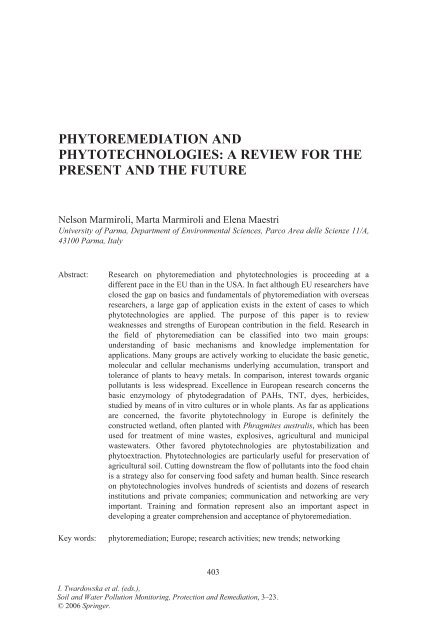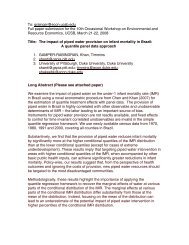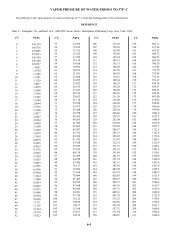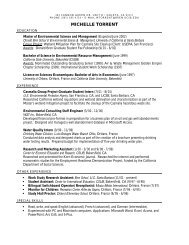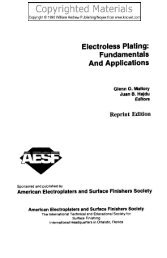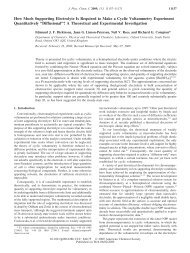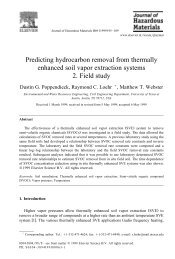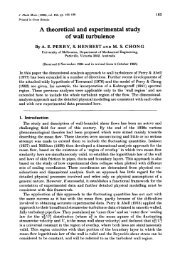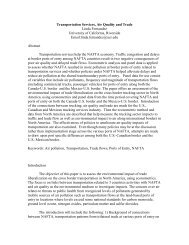PHYTOREMEDIATION AND PHYTOTECHNOLOGIES: A REVIEW ...
PHYTOREMEDIATION AND PHYTOTECHNOLOGIES: A REVIEW ...
PHYTOREMEDIATION AND PHYTOTECHNOLOGIES: A REVIEW ...
You also want an ePaper? Increase the reach of your titles
YUMPU automatically turns print PDFs into web optimized ePapers that Google loves.
404 Nelson Marmiroli, Marta Marmiroli and Elena Maestri1. INTRODUCTIONPhytoremediation, defined as the use of vegetation for in situ treatment ofcontaminated soils, sediments and water, is an environmental biotechnologythat has attracted recently the interest of scientists, public opinion,regulators, and public administration. Several extensive reviews and bookshave been written on this topic. As a book, a very extensive treaty is“Phytoremediation: Transformation and Control of Contaminants” edited in2003 by McCutcheon and Schnoor, and as a review the most recent is byElizabeth Pilon-Smits (2004). The purpose of this paper will be to review themost recent advances in this field, as they have been gleaned by meetings ofthe EC COST Action 859 “Phytotechnologies to promote sustainable landuse management and improve food safety”, which took place from late 2004through spring 2005 in Europe. In these meetings, the richness and diversityof research in European phytoremediation has emerged, a field in which USresearch has been one step ahead.1.1 Phytotechnologies and Their ApplicationThe traditional term of phytoremediation has been recently supplanted bythe term “phytotechnologies”, used to indicate all applications in whichplants are used to manage and control pollutants, even without removing ordestroying it (ITRC, 2001).Phytotechnologies are based upon the basic physiological mechanismstaking place in higher plants and associated microorganisms, such astranspiration, photosynthesis, metabolism, and mineral nutrition. Plants digtheir roots in soils, sediments and water, and roots can take up organiccompounds and inorganic substances; roots can stabilize and bind substanceson their external surfaces, and when they interact with microorganisms in therhizosphere. Uptaken substances may be transported, stored, converted, andaccumulated in the different cells and tissues of the plant. Finally, aerialparts of the plant may exchange gases with the atmosphere allowing uptakeor release of molecules. A series of six phytotechnologies have beenidentified (ITRC, 2001) which may address different contaminants indifferent substrates, and which rely on one or more of the plant properties asin the exemplification listed above:1. phytotransformation, ideal for organic contaminants in all substrates2. rhizosphere bioremediation, applied to organic contaminants in soil3. phytostabilisation, for organic and inorganic contaminants in soil4. phytoextraction, useful for inorganic contaminants in all substrates5. phytovolatilisation, which concerns volatile substances6. evapotranspiration, to control hydraulic flow in the contaminatedenvironment
Phytoremediation and Phytotechnologies405From knowledge of the basic phytoremediation, applications (phytotechnologies)have been designed which consider the appropriatecombination of plant choice and technology to address a specificcontaminated site. This list has been taken from the document prepared byITRC in 2001, even if different authors may identify a different set ofmethodologies:1. vegetative covers for control of infiltration2. vegetative covers for soil remediation3. hydraulic barriers4. tree stands for remediation of soil and groundwater5. treatment wetlands6. riparian buffers7. hydroponic systemsThese approaches differ in purposes and goals, which can be remediation,decontamination, control of water movement and leaching of thecontaminant, containment, stabilization. Once the goal is identified, thetechnique is applied by choosing the appropriate plants and the relevantphytotechnologies. Examples and case studies describing these applicationsmay be found in the specialised literature in books and in journals.1.2 Phytotechnologies in EuropeUse of phytotechnologies in Europe is limited, as compared with USAand Canada. In those countries, private companies have been formed withthe purpose to apply plant resources to control pollution (van der Lelie et al.,2001). European normative and public opinion are still precautionary in theuse of phytoremediation. The following constraints have been evidenced: due to limited knowledge and poor dissemination, there are doubts in thepublic opinion and limited acceptance, the current regulations, which do not clearly consider phytoremediationwithin the current applicable technologies unfavorable competition with standard clean-up methods, which canprovide a long-standing record of success lack of sufficient investments, for encouraging the private initiative proprietary rights, which may hinder application of approaches alreadyproved as successful in USAOne of the main constraints, however, rests on the lack of fundamentaland applied research. In fact, research on the basic mechanisms ofphytotechnologies and case studies are still needed in order to use thesetechnologies in a coherent way. Moreover, in the last FrameworkProgramme of the European Commission there was no topic really suitablefor presentation of projects on phytotechnologies, and most of the European
406 Nelson Marmiroli, Marta Marmiroli and Elena Maestriscientists have to rely on small budgets obtained from National or Regionalsources. Nevertheless, the EC has recently funded projects on this topic, aslisted in the CORDIS web site (www.cordis.lu), which have avoided acomplete blockage of research in phytoremediation. Another tool which wasinstrumental to maintain interest in phytoremediation and phytotechnologieshas been the COST Action 837 “Plant biotechnology for the removal oforganic pollutants and toxic metals from wastewaters and contaminatedsites” and the new one, 859, previously mentioned.A survey, carried out in April 2005, enlisted all scientists involved inphytotechnology research in Europe which could be found in publicationsindexed by ISI (Current Contents) and/or those who participated to theCOST meetings (see COST Actions www sites, lbewww.epfl.ch/COST837/and www.gre.ac.uk/cost859/). The countries involved were 29, includingIsrael and Turkey which participate to European projects. About 350research groups were involved, of which 60% were in Universities, 30% inresearch institutes and 10% in private companies. Indeed this distribution ofefforts may be biased by industrial research which, for competitionproblems, is limited in dissemination through journals.From papers published in 2001-2004, the distribution of topics forresearch is the same in Europe as in the USA, with most of the effortsconcentrated on understanding the basic principles of phytotechnologies. Anew trend is in the field of management and sustainability of enablingtechnologies. At this purpose different papers concern risk assessment andutilization of Decision Support Systems.Here follows a short review of recent results obtained by Europeanscientists, focused on the two main topics of principles of phytotechnologiesand implementation and use of phytotechnologies.2. BASIC PRINCIPLES OF<strong>PHYTOTECHNOLOGIES</strong>2.1 Basic Principles – Heavy Metals and InorganicContaminants2.1.1 Uptake and TransportInteraction among plants and metals starts in the root environment. Allphytotechnologies can be applied only if the contaminant is in contact withroots, and most of them rely on contaminant uptake by roots. This is the
Phytoremediation and Phytotechnologies407reason why plasma membrane transporters are a subject of research forphytotechnology implementation. Heavy metals uptake involves the samekind of transporters which otherwise provide macro- and micronutrientsentrance. Recently, Perfus-Barboech et al. (2002) have demonstrated theinvolvement of Ca channels in Cd uptake in Arabidopsis thaliana. Thepossibility of Cd mimicking Ca in plant cells can also justify its toxicity withperturbation of metabolism and homeostasis of this vital element.Studies performed with plant cell protoplasts have tried to ascertain ifdifferences in transport in sink tissues could explain the different behavior ofhyperaccumulator plants (Cosio et al., 2004). The results obtained with A.halleri and Thlaspi caerulescens show that plasma membranes of leaf cellsdo not account for differences in transport. Therefore, it has beenhypothesized that other mechanisms may be active to direct the metals totheir subcellular compartments, where they are stored: vacuoles andlignocellulosic material such as cell wall may be among these.Studies of metal transport, and especially in the case of radionuclides,can benefit from autoradiographic techniques, as shown by Soudek et al.(2004) with Cs. Imaging techniques allowed comparison between differentspecies for uptake efficiency, but they also revealed potential sink tissues,providing useful information for implementation of phytoextraction.2.1.2 Accumulation and SequestrationIn recent years, several authors have attempted to describe the differencesbetween hyperaccumulator taxa and non-accumulator congeners byexploiting analytical techniques which give information on speciation andlocalisation of metals in plant tissues. To understand the molecular bases ofthe hyperaccumulation capacity and to define the storage strategies will beinstrumental in developing and implementing phytoextraction. Analyticaltechniques based on X-ray emission (scanning electron microscopy andmicroanalysis) have been used to show Ni accumulation in the leaftrichomes of Alyssum bertolonii, in contrast with the non accumulatorAlyssum montanum which stores Ni in the roots (Marmiroli et al., 2004).Arabidopsis halleri, a Zn and Cd hyperaccumulator, has been studied bySarret et al. (2002). Zn is mainly sequestered in vacuoles of leaf trichomesand mesophyll cells. The authors determined through EXAFS that the twomain forms of Zn in the plant roots were malate and phytate (or possiblyphosphate), whereas in trichomes it is coordinated by C atoms, presumablybelonging to organic acids. Careful computations however suggest that Zn intrichomes, even if highly concentrated, cannot constitute the major sink.Another interesting result concerns Zn binding in the non accumulatorArabidopsis lyrata, in which phosphate species were predominantly
408 Nelson Marmiroli, Marta Marmiroli and Elena Maestriinvolved. With a similar approach based on EXAFS it has been possible toshow that Pb can be accumulated in roots of walnut trees by coordinationwith C atoms of cellulose and lignin (Marmiroli et al., 2005).2.1.3Identification of Genes and Proteins Involved In Toleranceand AccumulationTo unravel the molecular and biochemical mechanisms ofhyperaccumulation, the search for genes and proteins is being carried onwith genomics and proteomics approaches. Genomic efforts have beenpromoted by the EC in research projects studying the properties of thehyperaccumulators, and results are showing how different genes are inducedby metals in these plants and their congeners (van de Mortel et al., 2004).Comparative genomics and proteomics also contribute knowledge onorthologous genes, novel sequences, and molecular markers (Tuomainen etal., 2004).Bernard et al. (2004) have shown how ectopic expression of Thlaspigenes in yeast led to the isolation of a new gene function involved in Cdtransport and probably also hyperaccumulation, a P-type ATPase.Genetic mapping is the method of choice in the case of quantitative traits,and some authors are building maps of Quantitative trait Loci (QTLs) forhyperaccumulation and tolerance in model plants and in hyperaccumulators.Due to phylogenetic relationships with known hyperaccumulators in thefamily Brassicaceae, Arabidopsis thaliana is the best model plant available,due to the complete knowledge of the genomic sequence and to the geneticknowledge. The group led by Martin Broadley has recently mapped QTLinvolved in Cs accumulation of A. thaliana (Payne et al., 2004). Severalaccessions were analysed for Cs accumulation, leading to the description ofa 2-fold variation in Cs concentration. Crosses among contrastingphenotypes and analysis in segregating progenies led to mapping of putativeQTLs on several chromosomes; the existence of two QTLs on chromosomesI and V was confirmed from the analysis of segregating populations fromindependent crosses. Mapping of candidate genes in these regions will leadto new hypotheses about the structure and function of these QTLs.2.1.4 Genetic Bases of ToleranceClassical genetic studies have been exploited in order to address the issueof genetic bases of tolerance and/or accumulation in addition to genomic andproteomic approaches towards gene identification. For this purpose, modelplants of choice have traditionally been Arabidopsis halleri and Thlaspicaerulescens, two hyperaccumulators that can be crossed with non-
Phytoremediation and Phytotechnologies409hyperaccumulator ecotypes or congeners for studies of traits segregation.Genecological observations have demonstrated that tolerance to one heavymetal is a trait which is independent from accumulation of the same metal,and also that tolerance is controlled by few major genes. Interspecificcrosses between A. halleri and A. lyrata ssp. petraea have contributedinformation about tolerance and hyperaccumulation to Cd (Bert et al., 2003):tolerance and hyperaccumulation segregate as independent characters,whereas Cd tolerance co-segregates with Zn tolerance. Moreover Cd and Znhyperaccumulation seem to be co-regulated or controlled by the same genes.The same approach has been pursued in Thlaspi with ecotypes differingin accumulation capacity (Zha et al., 2004). Segregation results suggest that2 genes at least are responsible for Zn accumulation, whereas for Cdaccumulation more than one gene could be involved. Correlation betweenaccumulation of Zn, Cd and Mn is consistent with a multiple transporter withsimultaneous specificity for the three metals. Also in Thlaspi, Cd toleranceand accumulation segregate as independent characters.2.1.5 New ContaminantsPhytotechnologies have traditionally been applied to heavy metals,nutrients and radionuclides. New contaminants of interest include arsenic:only recently have hyperaccumulators for this element been described: thefern Pteris vittata (Zhao et al., 2003) and other species of the same genus(Zhao et al., 2002). Phytochelatins play a role in As tolerance, as reviewed inZhao et al. (2003), but in Pteris As is mainly in an inorganic form as arsenitein the vacuole of leaf cells. The authors suggest that phytochelatins mayhave a role in binding the small As quantities found in the cytoplasm.Mercury is also attracting new interest, and there are indications thatplants may be able to volatilize it as metallic mercury (Ernst et al., 2005).2.2 Basic Mechanisms – Organic Contaminants2.2.1 Mechanisms of Genetic Controls – Candidate GenesAs in the case of inorganic contaminants, also for organic contaminantsresearches are focusing on gene identification with a genomic approach.Recent advances concern specific candidate genes, coding for enzymeswhich are known to be involved in the metabolism of xenobiotics. The bestknown example is glutathione transferase (GST), a multigenic familyrecently reviewed by Frova (2003) and studied by the same author in rice(Soranzo et al., 2004). Plant genomes may contain between 25 and 60 GST
410 Nelson Marmiroli, Marta Marmiroli and Elena Maestrigenes. Five different classes are recognised in plant taxa, with two of themplant specific, Phi and Tau. Their main interest for phytotechnologies is theformation of glutathione-xenobiotic conjugates, in phase II of thecontaminant metabolism. Genomic approaches have led to the isolation andidentification of GST genes in important species, such as Arabidopsis, rice,maize, soybean. Rice contains 61 genes, 55% of which seem to be expressedbased on EST libraries. The Tau class is the most expressed. However, manyGST enzymes are inducible and expressed only in the presence of specificfactors. As far as genome structure is concerned, 30 GST genes cluster onchromosome 10 of rice; this feature is in common with other plant species.Evolutionary studies suggest that the plant-specific families Phi and Tauevolved in response to stress challenges by toxic compounds. Co-evolutionof GST and other enzymes involved in xenobiotic metabolism, cytochromesP450 and ABC transporters, will be of great interest to understand thebiochemical and physiological resources that plants can play to deal withcontaminants.2.2.2 Analysis and Identification of Enzymes and ProteinsFor identification of new enzymes involved in xenobiotic metabolismproteomic approaches are also pursued. A recent example is the isolation ofa new glucosyltransferase from Arabidopsis thaliana, responsible for thedetoxification of 3,4-dichloroaniline (Loutre et al., 2003). After purificationfrom in vitro cell cultures, the enzyme was characterised with MALDI-TOFMS and cloning of the gene was possible based on sequence information.Inducibility of the enzyme by herbicide safeners may contribute to elucidatethe interactions among xenobiotics and plant metabolism.2.2.3 Transgenic ApproachesMetabolic modification and degradation of a xenobiotic molecule maydepend on a single enzyme. A transgenic approach for modifying orimproving this enzyme with benefit for the relevant phytotechnology, istherefore conceivable. Examples reported in literature concern engineeringherbicide tolerance, since these compounds are completely assimilable toenvironmental xenobiotics. For instance, Diderjean et al. (2002) reported ofa successful transgenic approach with a gene for cytochrome P450, involvedin Phase I of the metabolism. The gene chosen is inducible by chemicalstress (metals and drugs) in Jerusalem artichoke, and it conferred resistanceto phenylurea upon transfer in the sensitive species tobacco and Arabidopsis.This gene may further be considered a useful tool for phytotransformationapplication in case of contamination by herbicides in soils and water.
Phytoremediation and Phytotechnologies411The following example is not concerned strictly phytoremediation, butrather phytomonitoring of organic compounds with a transgenic approach.The Danish company Aresa Biotechnology has developed a GM plant ofArabidopsis thaliana which can detect nitrogen dioxide emitted byexplosives and signal this contact by changing to red color (Anonymous,2003). The proposed application would be that of growing plants in areasaffected by anti-personnel mines in order to contribute to decontamination ofthe site.2.2.4In Vitro Studies for ImplementationCell cultures are utilized for bioassessment studies before practicalapplication in constructed wetlands, especially in the case of complexcontaminants, for which knowledge of the degradative patterns are notaccurate or existing at all. Species differ in their uptake and metaboliccapacities, and it has been shown that Carex (sedge) has negligible uptake ofTNT, different from Juncus, Phragmites or Typha (Gerth and Hartmut,2004).3. IMPLEMENTATION OF KNOWLEDGE FORAPPLICATION3.1.1 Constructed WetlandsApplication of constructed wetlands for treatment of contaminated watersis receiving growing interest in Europe. Several examples have beendescribed in different meetings. EC has supported the implementation of a10000 m 2 wetland in Portugal, to treat industrial effluents containing aniline,nitrobenzene and sulfanilic acid (Ramos et al., 2004). Other examples, whichcannot be cited here for space limitations, can be found in the abstractsbooks of COST (www.gre.ac.uk/cost859/).3.1.2 Short Rotation Coppice ForestryShort rotation coppice is a plantation of trees, poplars or willows, whichare kept for less than 15 years and produce plant biomass for severalpurposes in the paper and pulp industry. In particular, coppicing consists incutting the trunk at the base at intervals of 2-3 years, and new shoots emergefrom the stump. This type of forestry also represents a source of renewableenergy, constituting at the same time a sink for atmospheric carbon. Utilizing
412 Nelson Marmiroli, Marta Marmiroli and Elena Maestriplants which can take up heavy metals, consume CO 2 and produce biomass,combines forestry with phytotechnologies. Several authors are thereforestudying metal uptake in willow and poplar, in order to assess thebiodiversity existing among cultivars, clones and accessions. As a recentexample, poplar clones were analyzed for uptake of several metals, showinghow Cd, Zn, Al were taken up with high efficiency (Laureysens et al., 2004).3.1.3 Interactions with MicroorganismsIt is well known that plant-microorganisms interactions play importantroles in phytoremediation. In recent years discovery of the role ofendophytic bacteria in phytoremediation has led to several interestingconsiderations. Engineering endophytic bacteria of the species Burkholderiacepacia with plasmid pTOM increased degradation of toluene in yellowlupine plants (Barac et al., 2004), at the same time lowering toxicity to theplant.3.1.4 Atmosphere ContaminantsPhytotechnologies have traditionally been limited to contaminantsaccessible through plant roots, either in soil and sediments or in water.However, contaminants may enter the plant also from the atmosphere, and anew application of the phytotechnologies may be the removal of pollutantsfrom the troposphere (Morikawa et al., 2003). Nitrogen dioxide is a pollutantwhich may be taken up through stomata and incorporated into organiccompounds. There is extensive variability among plant taxa in this regard,and a survey of about 300 species showed that the most efficient plant isEucalyptus viminalis, 657 times more efficient than Tillandsia, the lessefficient taxon. These plants could be used to assembly “green walls”,covering the vertical surfaces of building where plants are able to assimilateNO 2 in great quantities. Recently the authors have described a positive effectof NO 2 on plant biomass growth, defining it as a “plant vitalisation signal”(Morikawa et al., 2005), but this still waits for a confirmation.4. NEW TRENDS4.1 Natural RemediationA new trend in use of phytotechnologies is favour encountered by theso-called “Assisted Natural Remediation”, clearly a non conventional
Phytoremediation and Phytotechnologies413application (Adriano et al., 2004). In Assisted Natural Remediation,amendments are added to the soil in order to accelerate natural processes ofremediation. In the case of metals, amendments contribute to immobilizationwith complexation, adsorption, precipitation and chemical reactions: themain purpose is to lower the bioavailability of the metal, and not its totalconcentration. The literature reviewed by Adriano et al. (2004) includessuccessful examples to which Assisted Natural Remediation has beenapplied.4.2 BiofortificationStudies on the interaction between plant tissues, heavy metals and/ortrace elements have led to the concept of biofortification, in which plantsenriched in micronutrient content are seen as an aid against malnutrition.Differently from phytoaccumulation of metals, which is considered as a riskfor the food chain, biofortification of crops with specific elements maybecome advantageous (Welch and Graham, 2004). Fortified crops aresuitable for growth on micronutrient-poor soil because their bioconcentrationcapacity will lead to higher content of micronutrients in edible tissues.Knowledge of mechanisms controlling metal accumulation is a prerequisitefor elucidating the biochemical basis of these phenomena. Information isalso requested for those antinutrients that decrease element availability:examples include phytic acid, fibres, and polyphenols.4.3 Glucosinolates and BiofumigationBiofumigation is a recent application of the properties of plant chemicals.In particular, several Brassicaceae are exploited in the fight towards pestsand pathogens in agriculture due to the production of specific secondarymetabolites called glucosinolates (Mithen, 2001). These sulfur-containingcompounds have an anticarcinogenic activity in man, they contribute to thecharacteristic flavor of cruciferous plants, and their degradation products candeter herbivores and inhibit microorganisms. From this derives the use ofBrassicaceae as “green manure” to be added to the soil during preparation, inorder to decrease the load due to pathogens and pests. This is a sustainablesubstitute to the use of chemical fumigants. An interesting feature still to beexplored is the possible connection between production of specificglucosinolates in the plant and the presence of heavy metals in theenvironment which may act as inducers or repressors. Since glucosinolatescontain sulfur, like metallothioneins and phytochelatins, they could have animpact in the sulfur metabolism of these heavy metal sequestering peptides.
414 Nelson Marmiroli, Marta Marmiroli and Elena MaestriThis in turn may determine an interlock during the process of pest resistanceand heavy metal resistance.5. CONCLUSIONSResearch on phytoremediation and phytotechnologies is thriving inEurope even despite lack of funding. Few EC funded projects and differentNational or regional activities has prevented research in this field to collapse.Networking activities such as those promoted within COST are also ofextreme importance for building interactions and collaboration amongscientists within and outside Europe. Other initiatives targeted atdissemination, education and training, should be activated in order toincrease the familiarity and confidence of the public opinion and ofstakeholders in these new sustainable technologies.ACKNOWLEDGEMENTSThe authors wish to thank Dr Andrea Pirondini, doctoral fellow in theDivision of Genetics and Environmental Biotechnologies for the literaturesearch. The project was carried out within the framework and activities ofCOST Action 859 and the NATO/Russia Council-CCMS project“development of a prototype system for sharing information related to actsof terrorism to the environment, agriculture and water systems”.REFERENCESAdriano, D. C., Wenzel, W. W., Vangronsveld, J., Bolan, N.S., 2004, Role of assisted naturalremediation in environmental cleanup, Geoderma 122:121–142.Anonymous, 2003, Plants that save lives, IPR Helpdesk Bulletin 13:7(www.ipr-helpdesk.org).Barac, T., Taghavi, S., Borremans, B., Provoost, A., Oeyen, L., Colpaert, J.V., Vangronsveld,J., van der Lelie, D., 2004, Engineered endophytic bacteria improve phytoremediation ofwater-soluble, volatile, organic pollutants, Nat. Biotechnol. 22:583–588.Bernard, C., Roosens, N., Czernic, P., Lebrun, M., Verbruggen, N., 2004 A novel CPx-ATPase from the cadmium hyperaccumulator Thlaspi caerulescens, FEBS Lett. 569:140–148.Bert, V., Meerts, P., Saumitou-Laprade, P., Salis, P., Gruber, W., Verbruggen, N. 2003,Genetic basis of Cd tolerance and hyeraccumulation in Arabidopsis halleri, Plant Soil249:9–18.Cosio, C., Martinoia, E., Keller, C. 2004, Hyperaccumulation of cadmium and zinc in Thlaspicaerulescens and Arabidopsis halleri at the leaf cellular level, Plant Physiol. 134:716–725.
Phytoremediation and Phytotechnologies415Diderjean, L., Gondet, L., Perkins, R., Lau, S-M. C., Schaller, H., O’Keefe, D. P., Werck-Reickhart, D. 2002, Engineering herbicide metabolism in tobacco and Arabidopsis withCYP76B1, a cytochrome P450 enzyme from Jerusalem artichoke, Plant Physiol. 130:179–189.Ernst, D., Battke, F., Halbach, S., 2005 Ascorbate promotes emission of mercury vapour fromplants, Abstracts of the 1 st Scientific Workshop and Management Committee Meeting ofCOST Action 859, p. 26.Frova, C., 2003, The plant glutathione transferase gene family: genomic structure, functions,expression and evolution, Physiol. Plant 119:469–479.Gerth, A., Hartmut, T., 2004, The role of plants in TNT-Phytoremediation, Abstracts ofCOST Action 859 1st WG2 Workshop, 2004 – Exploiting “-omics” approaches inphytotechnologies, p. 22.Interstate Technology and Regulatory Cooperation (ITRC), 2001, Phytotechnology Technicaland Regulatory Guidance Document. Available on Internet at www.itrcweb.orgLureysens, I., Blust, R., De Temmerman, L., Lemmens, C., Ceulemans, R., 2004, Clonalvariation in heavy metal accumulation and biomass pproduction in a poplar coppiceculture: I. Seasonal variation in leaf, wood and bark concentrations, Environ. Poll.131:485–494.Loutre, C., Dizon, D. P., Brazier, M., Slater, M., Cole, D.J., Edwards, R. 2003, Isolation of aglucosyltransferase from Arabidopsis thaliana active in the metabolism of the persistentpollutant 3,4-dichloroaniline, Plant J. 34:485–493.Marmiroli, M., Antonioli, G., Maestri, E., Marmiroli, N. 2005, Evidence of the involvementof plant ligno-cellulosic structure in the sequestration of Pb: an X-ray spectroscopy-basedanalysis, Environ. Poll. 134:217–227.Marmiroli, M., Gonnelli, C., Maestri, E., Gabbrielli, R., Marmiroli, N., 2004, Localisation ofnickel and mineral nutrients Ca, K, Fe, Mg with scanning electron microscopymicroanalysis in tissues of the nickel-hyperaccumulator Alyssum bertolonii Desv. and thenon-accumulator Alyssum montanum L. Plant Biosystems 138:231–243.McCutcheon, S. C., Schnoor, J. L., eds., 2003, Phytoremediation: Transformation andControl of Contaminants, Wiley, New York.Mithen, R., 2001, Glucosinolates – biochemistry, genetics and biological activity, PlantGrowth Regul. 34:91–103.Morikawa, H., Takahashi, M., Hakata, M., Sakamoto., A. 2003 Screening and geneticmanipulation of plants for decontamination of pollutants from the environments,Biotechnol. Adv. 22:9–15.Morikawa, H., Takahashi, M., Nakagawa, M., Sakamoto, A., Ohsumi, C., Matsubara, T.,2005, Atmospheric nitrogen dioxide as a plant vitalization signal to improve size and cellconstituent, Abstracts of the 1 st Scientific Workshop and Management Committee Meetingof COST Action 859, p. 189.Payne, K. A., Bowen, H. C., Hammond, J. P., Hampton, C.R., Lynn, J. R., Mead, A., Swarup,K., Bennett, M. J., White, P. J., Broadley, M. R., 2004, Natural genetic variation incaesium (Cs) accumulation by Arabidopsis thaliana, New Phytol. 162:535-548.Perfus-Barbeoch, L., Leonhardt, N., Vavasseur, A., Forestier, C., 2002, Heavy metal toxicity:cadmium permeates through calcium channels and disturbs the plant water status, Plant J.32:539–548.Ramos, H., Davies, L., Carias, C., Novais, J., Martins-Dias, S., 2004, Phytoremediation oforganic compounds in constructed wetlands, Abstracts of COST Action 859 1st WG4Workshop, 2004 – Integration and application of phytotechnologies, p. 8.
416 Nelson Marmiroli, Marta Marmiroli and Elena MaestriSarret, G., Saumitou-Laprade, P., Bert, V., Proux, O., Hazemann, J-L., Traverse, A., Marcus,M. A., Manceau, A., 2002, Forms of zinc accumulated in the hyperaccumulatorArabidopsis halleri, Plant Physiol. 130:1815–1826.Soranzo, N., Sari Gorla, M., Mizzi, L., De Toma, G., Frova, C., 2004, Organisation andstructural evolution of the rice glutathione S-transferase gene family, Mol. Gen. Genomics271:511–521.Soudek, P., Tykva, R., Vanek, T. 2004, Laboratory analyses of 137 Cs uptake by sunflower,reed and poplar, Chemosphere 55:1081–1087.Tuomainen, M., Nunan, N., Lehesranta, S., Tervahauta, A., Hassinen, V., Schat, H., Auriola,S., McNicol, J., Karenlampi, S., 2004, Proteomics and metal-responsive proteins inThlaspi. Abstracts of COST Action 859 1st WG2 Workshop, 2004 – Exploiting “-omics”approaches in phytotechnologies, p. 42.Van de Mortel, J., Rigola, D., Talukdar, S., Fiers, M., Pieper, B., Moeller, B., Schat, H.,Aarts, M., 2004, Comparative genomics of Zn accumulation in Thlaspi caerulescens andArabidopsis thaliana, Abstracts of COST Action 859 1st WG2 Workshop, 2004 –Exploiting “-omics” approaches in phytotechnologies, p. 8.Van der Lelie, D., Schwitzguebel, J. P., Glass, D. J., Vangronsveld, J., Baker, A. J. M., 2001,Assessing phytoremediation’s progress in the United States and Europe, Environ. Sci.Technol. 35:446A-452A.Welch, R. M., Graham, R. D., 2004, Breeding for micronutrients in staple food crops from ahuman nutrition perspective, J. Exp. Bot. 55:353–364.Zha, H. G., Jiang, R. F., Zhao, F-J., Vooijs, R., Schat, H., Barker, J. H. A., McGrath, S. P.2004, Co-segregation analysis of cadmium and zinc accumulation in Thlaspi caerulescensinterecotypic crosses, New Phytol. 164:299–312.Zhao, F-J., Dunham, S. J., McGrath, S. P., 2002, Arsenic hyperaccumulation by different fernspecies, New Phytol. 156:27–31.Zhao, F-J., Wang, J. R., Barker, J. H. A., Schat, H., Bleeker, P. M., McGrath, S. P. 2003, Therole of phytochelatins in arsenic tolerance in the hyperaccumulator Pteris vittata. NewPhytol. 159:403–410.


